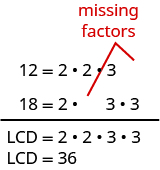Adding and Subtracting Fractions With Different Denominators
Learning Outcomes
- Add or subtract fractions with different denominators
- Identify and use fraction operations
Least Common Denominator
The least common denominator (LCD) of two fractions is the least common multiple (LCM) of their denominators.Equivalent Fractions Property
If are whole numbers where
Add or subtract fractions with different denominators
- Find the LCD.
- Convert each fraction to an equivalent form with the LCD as the denominator.
- Add or subtract the fractions.
- Write the result in simplified form.
Example
Add: Solution:| Find the LCD of , . |  |
| Change into equivalent fractions with the LCD . | |
| Simplify the numerators and denominators. | |
| Add. |
Try It
[ohm_question height="230"]146262[/ohm_question]Example
Subtract:Answer: Solution:
| Find the LCD of and . |  |
| Rewrite as equivalent fractions using the LCD . | |
| Simplify the first fraction. | |
| Subtract. | |
| Simplify. |
Try It
[ohm_question height="230"]146264[/ohm_question]Example
Add:Answer: Solution:
| Find the LCD of and . |  |
| Rewrite as equivalent fractions with the LCD. | |
| Simplify the numerators and denominators. | |
| Add. |
Try It
[ohm_question height="230"]146265[/ohm_question] The LCD, , has factors of and factors of .
Twelve has two factors of , but only one of —so it is ‘missing‘ one . We multiplied the numerator and denominator of by to get an equivalent fraction with denominator .
Eighteen is missing one factor of —so you multiply the numerator and denominator by to get an equivalent fraction with denominator . We will apply this method as we subtract the fractions in the next example.
The LCD, , has factors of and factors of .
Twelve has two factors of , but only one of —so it is ‘missing‘ one . We multiplied the numerator and denominator of by to get an equivalent fraction with denominator .
Eighteen is missing one factor of —so you multiply the numerator and denominator by to get an equivalent fraction with denominator . We will apply this method as we subtract the fractions in the next example.
Example
Subtract:Answer: Solution:
| Find the LCD. |  is 'missing' a factor of
is 'missing' a factor of |
| Rewrite as equivalent fractions with the LCD. | |
| Simplify each numerator and denominator. | |
| Subtract. | |
| Rewrite showing the common factor of . | |
| Remove the common factor to simplify. |
Try It
[ohm_question height="230"]146266[/ohm_question]Example
Add:Answer: Solution:
Find the LCD.
 |
|
| Rewrite as equivalent fractions with the LCD. | |
| Simplify each numerator and denominator. | |
| Add. | |
| Rewrite showing the common factor of . | |
| Remove the common factor to simplify. |
